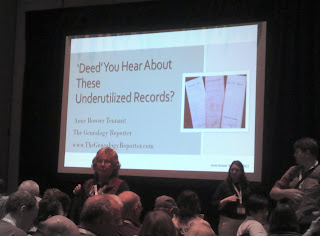Actually, for the first decade of our marriage, I paid absolutely no attention to our families' roots. But once I caught the genealogy bug, it was full speed ahead, starting with the bits and pieces in the family's possession.
As shown in the handwritten note passed down from his Granddaddy Brice Larimer McClure (1878-1970), there were clear clues to Irish ancestry on hubby's mother's side of the family. Following up on these and other clues, here's what I learned about his Irish ancestors:
• John Shehen and his wife, Mary, from somewhere in Ireland (possibly south) - Hubby's 2d great-grandparents. They were born around 1800 in Ireland but were in London by the 1830s. John and Mary’s daughter, Mary Shehen, married John Slatter in England. Their youngest daughter Mary Slatter grew up, married James Edgar Wood, and became hubby's grandma. [Too many Marys and Johns, don't ya think?]
• William Smith and his wife, Jean, were from Limerick – His 5th great-grandparents. Their son Brice Smith was the first Brice in the family and was the first son born to these ancestors in America. There have been several other men named Brice since then, including hubby's Granddaddy.
• Robert Larimer and his wife, Mary O’Gallagher, both from the North of Ireland - Hubby's 5th great-grandparents. Robert was shipwrecked while sailing from No. Ireland to America and then served as an indentured servant to work off the cost of his rescue. He finally ran away, married Mary, and settled down to farming. McKibbin and Short cousins from the North of Ireland were known to intermarry with the Larimer branch in America.
• Halbert McClure and his wife, Agnes, were born in County Donegal, in the North of Ireland (although the McClure family is originally from Isle of Skye in Scotland) - Hubby’s 5th great-grandparents. This family sailed to Philadelphia as a group and then walked 200 miles to Virginia to buy land for farming in the 1730s.
Every year, I write my grandchildren to share the latest info about their Irish roots. There's always something new to investigate, someone new to discover among these branches of the tree. Lucky me, I married him for his ancestors.
Thanks to Amy Johnson Crow for the "lucky" prompt in Week 11 of her #52Ancestors series.









































